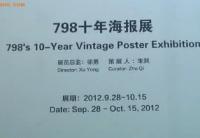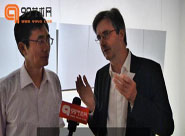Living in the Future’s Reality
Text / Feng Boyi
Translation/Fiona He
German-based artist Yuan Shun’s series works uses different media such as installation, photographs, video and sketches to provide and showcase a fictional view. The smoke-enveloped landscape conjures up his imagination of space, nature, the city and humanity. It is set in a structure that’s between “form” and “formlessness”, “fiction” and “substance”, that seems to transport the viewer into an increasingly fictionalized realm. In my view, this fiction corresponds to a certain desire of the Chinese people, and a certain imagining of the future.
In today’s China, cities seem to have been “borrowed” from the future. In almost every city one goes to in China, the urban mapping for the future makes you want to offer your own ideas. The planning of many not yet built cities or representative landmarks are transformed into dreams that are more realistic than the actual urban space. Even though it is fictional, it is also real, reflecting China’s rapid speed of development. The views of these cities are more city-like than the ones we are actually living in. These cities are extremely clean, fluid, free of chaos, and highly logical. They reveal a kind of strange “futurism”, without the chaos of a real city – a vivid reality, but the fictional city exists only in the mind. Nonetheless, this city is unquestionably more realistic than the ones we are surrounded by, with their various problems, inconveniences and challenges. This other city shows us the alternative reality with an alternative method, a reality that’s more realistic. It seems to be the contrary of the film Matrix, those living in the Matrix were fearful of the simulated world in the computer, and spare no efforts to return to the “ruins of reality”. Yet, we need this simulated world to help us transcend immediacy. The reality Yuan Shun’s work targets could be precisely that which allows us to transcend reality. Because current Chinese cities thinks their pasts are not sufficient to symbolize their reality, but instead borrow from the future to represent the present. The future has now became the symbol of every city in China. The fervor for destroying Chinese creations is at its peak, there is a desperate imposition of symbolic images of the future to the present. Such an impulse comes from the formation and realization of a new Chinese dream. This Chinese dream is no longer the extension of the hundred year dream of self-strengthening. Rather, this dream is of a search for success, the applying of one’s own ability to actualize a dream for the future. This dream can only be futuristic, thus it is inevitable that cities construct themselves in a stimulated dimension.
Yuan Shun’s experience and memories before going abroad, and his more than ten years of living and traveling in Germany have revealed that after pursuing a move beyond the lifelike and self-transcendence in a new discourse, he now demonstrates a sense of helplessness towards reality and a loss of command over this endless contradiction. The interesting point in the Soft Landing series is its spatial relationship, resulting from Yuan Shun’s own experience, memories, imagination and other rhythms, both psychological and emotional. Through expansion, it provides us with a representation of one’s fate in the space in which one exists. Here, the figurative mountains, the rising and falling of simulated roads, and the buildings are not only decoration, but are key clues. Cities and the process of urbanization should not be considered as scenery, but are actually an allusive representation. The familiar streets, familiar histories, familiar life details and childhood environments, are parts of precious individual experience and memories of regional culture. In an era when the globalization of culture is progressing like wild grass, whether consciously or not, these have become important sources with which to safeguard “originality” and rebel against “categorization”, to provide a base for “security”. Yuan Shun’s work not only conveys to others a reality that’s taking place, but also delineates a contrast between history, the present and the future, as well as the cause effect relationship behind it. We can strongly and rapidly sense the idea the artwork expresses: the future exists an expansion of the present, and the present exists in the promise of the future. Therefore the mix of the present and future becomes the key to this problem. The meaning expressed by Yuan Shun is not only limited to the new visual concepts and methods applied to this simulated city, a city to him is also a record of spiritual and emotional history, as well as a unique awakening and creation existing within the hard to identify “reverberation of urbanization.”
Living in awkwardness seems, for urban dwellers, to be living in a gap - compressed existence and spirit. It is difficult to find a place for honest living or for the spirit to rest. Here, Yuan Shun is a different type of city-dweller. His sensitivity to the accumulated urban experience, his reflections, his musing in humoristic ways are all worth our attention. Perhaps it is also for this reason that the dramatic effects of the simulated landscape in his works are built on these two values. Thus, we can perceive what is before our eyes. This represents an unprecedented force forward, a new spirit and impulse. In fact, it is each individual’s search for his own success, and every individual’s efforts to improve his own life. Of course, the problem here is that a time borrowed from the future probably makes us forget about our memories of the past, and perhaps also about those living real lives. However, as we call on the future, we still need the present and the past. The force of Chinese development is unprecedented for this country and nation, and we must treat it with care; the same is true for the impulses of Chinese people. Without such impulses and forces, we can’t welcome the future. Yuan Shun’s work, vis-à-vis the present, the past and the future, has provided extremely incisive observation and reflection. It reveals an interesting and unique artistic imagination and a transposition of changes taking place in China.
Beijing, March,2007
【编辑:小红】

